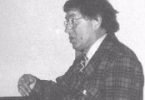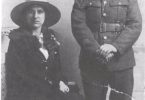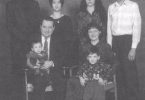Biography written by Suzanne Toal
It was love at first sight. When twice-widowed Martha McQueen (now Martha Godlonton) arrived in Banff from her native Scotland in July, 1973, to stay with relatives and begin a working holiday, it was late in the evening and very dark. A first-time flyer, Martha felt tense and weary after the long journey. Next morning when she woke up refreshed, and stepped out the door, she viewed the splendour of the mountain scenery unfolding before her and knew that the Bow Valley was the place where she wanted to spend the rest of her life.
Born in Glasgow in 1911, Martha Lamont was the only girl and the youngest of a family of fourteen, most of whom did not survive infancy. Her father, who was working in South Africa when she was born, never saw his much-longed-for daughter. He died in an accident, clutching her photograph, the same day he received the news that he was the father of a little girl.
Martha’s mother struggled to make ends meet and was unable to make home for her children. Martha (a tomboy as a child who loved scaling drainpipes, doing cartwheels and playing cricket) went into domestic service when she was fifteen and for the next seven years until she got married, did several jobs in that field. These included a stint on a farm where she did light housekeeping and sewing, and travelling around Scotland with a carnival where she helped with the equipment and acted as nanny to the children.
“Working in domestic service suited me,” Martha recalls, “as I had no home to go to. It was a changeable life. I never knew when I would be some place else. But I was fortunate. People took interest in me and helped me. I wasn’t treated like a servant but as one of the family. The families I worked for were upper class. I had to be careful how I spoke and acted. I was called
“snooty” when I returned to rough and ready Glasgow.”
Returning to Glasgow on holiday, Martha met her first husband, Henry MacFarlane. They married in 1933 when Martha was twenty-two. Henry, who was ten years her senior, was in bad
health and succumbed to complications from tuberculosis in 1947. They had one child, who died when he was four.
It was Macfarland Lang’s biscuit factory in Glasgow that played cupid to Martha two years later and indirectly piqued her interest in Canada. She met her second husband, James McQueen, at
the factory – he was employed as a laundryman, she as a cleaner. A widower with nine children, he had returned to Scotland from Glace Bay, Nova Scotia, at his first wife’s insistence. Martha and James met in January, 1950, and were married in March of the same year.
The couple secured a new home in Glasgow using James’s title to property in Nova Scotia as collateral. They were blessed with two healthy children. Martha recalls how this was a wish come true for her. As a young schoolgirl, she enjoyed participating in a playground skipping game whose aim was to predict future marriage prospects and progeny! The young Martha had always hoped for a home of her own, along with two children, a boy and a girl.
Marriage to James McQueen gave Martha the home, family and security she had always longed for, but when James passed away in December, 1969, she felt the necessity to return to domestic service once more. She worked as a seasonal housemaid in a hotel on the Isle of Arran and in Butlin’s Holiday Camp in Ayre. It was at this time that she received the invitation from her stepdaughter and husband, who were employed in the Banff Springs Hotel, to come to the Canadian Rockies for a six-week holiday. Martha took the practical step of securing a work permit before she left Glasgow.
After falling in love with the Rockies and only four weeks holiday, she started work in the Banff Springs Hotel as a chambermaid. In November of that year (1973), she applied for immigrant status as the Trudeau government was preparing to pass the current law which requires that potential immigrants apply from outside Canada.
With her new job, relatives to sponsor her, and adequate pension funds from Britain, Martha was finally independent. The following year she rented an apartment in Banff and continued to work at the Springs until her retirement at age sixty-five.
It was in her retirement year, 1976, that she met her third husband, widower Clifford Earnest Godlonton. A member of the Legion in Banff, Clifford belonged to an Alberta pioneer family which had moved from Edmonton to Calgary, living not far from Indian Tent Village. After his first wife died, Clifford had lived for a time with his daughter in Lethbridge, eventually moving to Banff.
The couple met at the Legion, became friends, dated for three years and married in 1981. Martha expresses some bewilderment at this turn of events, stating that she had no intention of marrying again, even though Clifford always maintained that she had asked him! She remarks that they had decided to pool their resources. Two could live as cheaply as one.
One important decision that faced the couple was finding suitable accommodation and it was to this end that they moved into the new Bow River Homes in Canmore in March, 1983. Clifford, who was twelve years older than Martha, passed away in 1995.
Martha, who never knew her father, was puzzled as a child by the concept of ‘father’. Eventually, after attending Bible School, she delightedly told friends that she did have a father – a heavenly father – the Creator. It is interesting that each of her three husbands was significantly older than she and, although quite different in personality and background, they held in common the paternal values of the importance of home and family, of stability and security. Martha even remarks coyly that she has received several proposals of marriage from younger men but she wasn’t attracted to them!
She found happiness and contentment with each of her three husbands but not her real soul mate. Although their attitudes towards certain things were different from hers, the couple, in each case, always supported one another and made home and family priority.
This sprightly, energetic eighty-eight year old, who is now a great-great-grandmother, enjoys life to the full. She goes for walks, is an active church member, a member of the senior choir, listens to music, reads and travels. She embraces new experiences willingly, participating fully in the social life at the Lodge and Drop-In Centre. She believes that her decision to stay in Canada was a watershed in her life, highly beneficial to her health and welfare. She can cope with the climate and loves the scenery and the lifestyle.
Reflecting on her long and eventful life with its many twists and turns, Martha muses that one constant for her has been the need to adapt to change. She jokes: “I wonder if, when I come into the Millennium, will I be moving again”? Is there a possibility of husband number four? Martha adamantly rejects the suggestion. But then, who knows?
In Canmore Seniors at the Summit, edited by Canmore Seniors Association (Friesens Corporation: 2000), 97-98.







